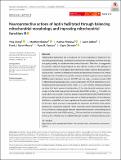Files in this item
Neuroprotective actions of leptin facilitated through balancing mitochondrial morphology and improving mitochondrial function
Item metadata
| dc.contributor.author | Cheng, Ying | |
| dc.contributor.author | Buchan, Matthew | |
| dc.contributor.author | Vitanova, Karina | |
| dc.contributor.author | Aitken, Laura | |
| dc.contributor.author | Gunn-Moore, Frank J | |
| dc.contributor.author | Ramsay, Rona R. | |
| dc.contributor.author | Doherty, Gayle | |
| dc.date.accessioned | 2020-04-09T15:30:01Z | |
| dc.date.available | 2020-04-09T15:30:01Z | |
| dc.date.issued | 2020-10-13 | |
| dc.identifier | 266884705 | |
| dc.identifier | 6e1e06df-cd5f-45dc-ad87-fedbb699edd9 | |
| dc.identifier | 85082929284 | |
| dc.identifier | 000559593600001 | |
| dc.identifier.citation | Cheng , Y , Buchan , M , Vitanova , K , Aitken , L , Gunn-Moore , F J , Ramsay , R R & Doherty , G 2020 , ' Neuroprotective actions of leptin facilitated through balancing mitochondrial morphology and improving mitochondrial function ' , Journal of Neurochemistry , vol. 155 , no. 2 , e15003 , pp. 191-206 . https://doi.org/10.1111/jnc.15003 | en |
| dc.identifier.issn | 0022-3042 | |
| dc.identifier.other | RIS: urn:3D5B72EC44371A30DB4C6EC0B978EA3D | |
| dc.identifier.other | ORCID: /0000-0003-1535-4904/work/71954811 | |
| dc.identifier.other | ORCID: /0000-0003-3422-3387/work/71954844 | |
| dc.identifier.other | ORCID: /0000-0003-3494-5857/work/71954983 | |
| dc.identifier.other | ORCID: /0000-0001-7259-4491/work/71955028 | |
| dc.identifier.uri | https://hdl.handle.net/10023/19774 | |
| dc.description | Authors would like to acknowledge ARUK for supporting this research. YC is Chinese Scholarship recipient. The University of St Andrews is a charity registered in Scotland: No SC013532 | en |
| dc.description.abstract | Mitochondrial dysfunction has a recognised role in the progression of Alzheimer's disease (AD) pathophysiology. Cerebral perfusion becomes increasingly inefficient throughout ageing, leading to unbalanced mitochondrial dynamics. This effect is exaggerated by amyloid β (Aβ) and phosphorylated tau, two hallmark proteins of AD pathology. A neuroprotective role for the adipose‐derived hormone, leptin, has been demonstrated in neuronal cells. However, its effects with relation to mitochondrial function in AD remain largely unknown. To address this question, we have used both a glucose‐serum deprived (CGSD) model of ischaemic stroke in SH‐SY5Y cells and a Aβ1‐42‐treatment model of AD in differentiated hippocampal cells. Using a combination of JC‐1 and MitoRed staining techniques, we show that leptin prevents depolarisation of the mitochondrial membrane and excessive mitochondrial fragmentation induced by both CGSD and Aβ1‐42. Thereafter, we used ELISAs and a number of activity assays to reveal the biochemical underpinnings of these processes. Specifically, leptin was seen to inhibit upregulation of the mitochondrial fission protein Fis1 and downregulation of the mitochondrial fusion protein, Mfn2. Furthermore, leptin was seen to upregulate the expression and activity of the antioxidant enzyme, monoamine oxidase B. Herein we provide the first demonstration that leptin is sufficient to protect against aberrant mitochondrial dynamics and resulting loss of function induced by both CGSD and Aβ1‐42. We conclude that the established neuroprotective actions of leptin may be facilitated through regulation of mitochondrial dynamics. | |
| dc.format.extent | 2564591 | |
| dc.language.iso | eng | |
| dc.relation.ispartof | Journal of Neurochemistry | en |
| dc.subject | Hippocampal | en |
| dc.subject | Leptin | en |
| dc.subject | Mitochondrial fission | en |
| dc.subject | Mitochondrial fusion | en |
| dc.subject | Mitochondrion | en |
| dc.subject | Monoamine oxidase | en |
| dc.subject | RC0321 Neuroscience. Biological psychiatry. Neuropsychiatry | en |
| dc.subject | DAS | en |
| dc.subject.lcc | RC0321 | en |
| dc.title | Neuroprotective actions of leptin facilitated through balancing mitochondrial morphology and improving mitochondrial function | en |
| dc.type | Journal article | en |
| dc.contributor.institution | University of St Andrews. School of Psychology and Neuroscience | en |
| dc.contributor.institution | University of St Andrews. School of Biology | en |
| dc.contributor.institution | University of St Andrews. Biomedical Sciences Research Complex | en |
| dc.contributor.institution | University of St Andrews. Sir James Mackenzie Institute for Early Diagnosis | en |
| dc.contributor.institution | University of St Andrews. Centre for Biophotonics | en |
| dc.contributor.institution | University of St Andrews. Institute of Behavioural and Neural Sciences | en |
| dc.identifier.doi | https://doi.org/10.1111/jnc.15003 | |
| dc.description.status | Peer reviewed | en |
This item appears in the following Collection(s)
Items in the St Andrews Research Repository are protected by copyright, with all rights reserved, unless otherwise indicated.

